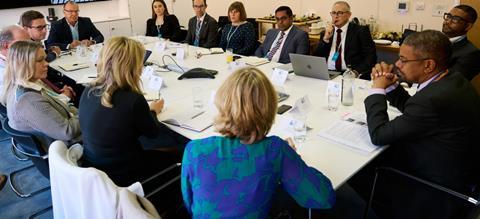With construction driving a good chunk of the Welsh economy, this part of the UK offers promising opportunities for the sector. At our final Building the Future Commission regional roundtable, held in Cardiff, panellists considered how best to smooth the industry’s pathway to success. Jordan Marshall reports


“Construction is a really big part of our economy – it represents over 100,000 jobs and is actually a bit more vibrant,” said Vaughan Gething, minister for the economy in the Welsh government.
“There is of course a lot of difficulty at the moment. We have all the predictions of recession, magnifying the real challenge of what business investment looks like, and other issues such as the labour and skills shortages. At the same time, it is important we are not losing sight of the fact it is a sector with a very real upside.”
Gething was speaking at the Building the Future Commission’s final regional roundtable for 2023, which took place last month in Cardiff and focused on the construction landscape in Wales, exploring the opportunities, risk factors and solutions for the sector.
Since the start of the year, the Building the Future Commission has been working to discover solutions and initiatives to improve the built environment. The project does not focus on one area but instead is divided into eight workstreams focused on different aspects of the industry.
As part of the commission’s fact-finding work, and in partnership with Constructing Excellence, we have been travelling around the country convening high-level roundtable discussions with experts in different regions to ensure that the commission hears from all corners of the UK.
The first of these saw Building gather a group of experts who each have links to the East of England for a chat about skills in a region that some see as living in London’s shadow, before the commission’s roadshow headed to Newcastle to hear from those in the North-east on net zero.
The next two events were held in Manchester and Birmingham, focusing on the opportunities and challenges of devolution and the levelling up agenda.
The fifth and final stop for the year in Cardiff, chaired by Building’s editorial director Chloë McCulloch and supported by AtkinsRéalis, was made up of construction leaders all of whom have strong connections to the region and bring with them a high level of local knowledge and experience.
The challenges
“There are opportunities around retrofit; there are people in this sector who are committed to its future. I’m interested in how we accept and recognise what the challenges are and then reflect what we think the opportunities are. In my role as minister, I want to be clear about both sides of that,” Gething continued.
At this point in the conversation, talk turned to the industry specialists to identify both their key concerns and solutions (see recommendations box) with some of the core concerns identified including procurement challenges, particularly for SMEs, and the ongoing skills and labour shortages.

Ann-Marie Smale, managing director of Powell Dobson Architects, said that in a small or medium-sized enterprise (SME) the current procurement routes in Wales are prohibitive.
She said: “What we don’t do well is the actual joining up. All the local authorities approach procurement in a different way. For example, there are a million frameworks you could get on but it’s a crazy amount of resource of time for SMEs to get on.”
She added that if there was a better joined-up system, there would be efficiencies gained in the procurement process.
Around the table:
• Chair: Chloë McCulloch, editorial director, Building
• Vaughan Gething, minister for the economy, Welsh government
• Brendon Baker, cities and infrastructure adviser, Mott MacDonald
• Richard Bonner, market director for buildings and places, AtkinsRéalis
• Grace Day, infrastructure and constructionsolicitor, Geldards
• Jane O’Leary, sector director – education, ISG
• Ed Evans, director, Civil Engineering Contractors Association (Wales)
• Simon Griffiths, director for supply chain excellence, Opus
• Catherine Griffith-Williams, CEO, Constructing Excellence Wales
• Kamal Rajput, strategic business development lead, Tata Steel
• Anthony Rees, regional manager, Cyfle Building Skills
• Ann-Marie Smale, managing director, Powell Dobson Architects
• Sean Taylor, planning manager, Dandara Homes
• Richard Wilson, deputy director for the business and regions directorate, economy, treasury and constitution group, Welsh government
Ed Evans, director of the Civil Engineering Contractors Association (Wales), said SMEs are beginning to view working for the public sector in Wales as too risky due to procurement and fixed project costs and this needs to be addressed.
“I don’t think we should shy away from that, because it has the potential to create opportunities through the supply chain, but if processes are too bureaucratic we’re losing the opportunity of that public sector spending going to the SMEs.”
On this point Jane O’Leary, sector director for education at ISG, agreed that while the Consortium of Local Authorities in Wales (CLAW) has tried to come up with a coherent approach for not only procurement but also MMC use and project delivery, there is definitely an opportunity to be seized if a unified system can be developed in these areas.
The opportunities
When it comes to skills, Anthony Rees, regional manager at Cyfle Building Skills, said that while training courses and pathways are attracting more than enough people, the attrition rate is extremely high – meaning that if the issues in the system are addressed there could be a significant pipeline of new workers.
“I deal with five colleges in my role, and the transition rate into full-time work is 30%,” he said. “We need to be a bit more selective. I think more money needs to go towards the transition process and for the transfer into meaningful jobs, not at the front end of recruitment. We need more pathways into anchor organisations.”

Sean Taylor, planning manager at Dandara Homes, agreed that there are significant gains to be made in the Welsh labour market if diversity and inclusion are considered more fully. “There are pools of talent out there that have not been tapped either fully or at all.”
He said the Royal Town Planning Institute has been trying to engage with women and people from different cultural backgrounds, focused on “spreading the word about opportunities in the sector and measuring the gap response that comes back”. There is much the sector could do in this arena, he added.
What is the Well-being of Future Generations (Wales) Act 2015?
The Well-being of Future Generations (Wales) Act is about improving the social, economic, environmental and cultural wellbeing of Wales. The legislation gives a legally binding common purpose – the seven wellbeing goals – for national government, local government, local health boards and other specified public bodies. It details the ways in which specified public bodies must work, and work together, to improve the well-being of Wales. It demands that the public bodies listed in the act think more about the long term, work better with people and communities and each other, look to prevent problems and take a more joined-up approach.
One of the opportunities identified by the panel was the potential for meaningful social value delivery if companies are better held to account, with Catherine Griffith-Williams, chief executive of Construction Excellence Wales, saying that the Well-being of Future Generations (Wales) Act (see panel) is a prime example of this. “When you look at it, no one is asking for the data. But if we have a joined-up repository of data and examples of good practice, it shows what the sector can do. It can inspire.”
Grace Day, infrastructure and construction solicitor at Geldards, concurred that tracking progress is key for harnessing regulatory opportunities. “You can put clauses in contracts, but that doesn’t guarantee things are being delivered. When it comes to the Well-being of Future Generations (Wales) Act, at the moment it feels like there has been a lot of talk but not any real significant opportunity. That does mean there is still an opportunity to be harnessed there.”
The solutions
As the roundtable approached its end after an hour and a half of vigorous debate, the panel were asked to come out with proposals for the Building the Future Commission on the best solutions for the Welsh construction sector.
Top recommendations
A consistent, visible pipeline of public work
Simon Griffiths, director for supply chain excellence at Opus, said the need for platforms such as Sell2Wales to provide a unified pipeline of work is crucial. He said: “Having clear pipelines of work allows for proper planning and recruitment. Firms can plot what they need and plot how they can employ more apprentices and graduates.” Powell Dobson Architects’ Ann-Marie Smale added that a consistent point of procurement would be very helpful for SMEs looking to work with the public sector.
Tap into other labour markets
Brendon Baker, cities and infrastructure adviser at Mott MacDonald, said Taylor’s point on untapped pools of talent is a key one. He added: “Alongside women and people from diverse cultural backgrounds, it is important to consider how we engage groups such as the long-term unemployed and former military.” Griffiths added there is also potential from released prisoners – though the transient nature of construction needs to be addressed. O’Leary added that the rise of MMC and DfMA could assist with this.
Ensure social value is meaningful
“We can do social value much, much better at the moment as it is still very, very transactional. We need more collaboration between the public and private sector on this front,” said Richard Bonner, market director for buildings and places at AtkinsRéalis. “Really the need is in local communities; it’s with local authorities. We can be much smarter with what we deliver, but we need to all be working together.”
Maximising wider opportunities
Kamal Rajput, strategic business development lead at Tata Steel, said it is integral that the sector makes the most of broader opportunities such as offshore wind farms by ensuring there is capacity in the supply chain. “For example, offshore wind opportunities are ones that the built environment certainly supports. That complements the offshore benefits in the country more broadly if we can deliver. On the ground, that is about trying to look at supply chain capability from the bottom up as opposed to top down.”
Responses (see panel) included suggestions on visibility of pipeline, how to enable change within the construction supply chain, what is needed to maximise true social value, and the importance of broadening the search for skills.
The key takeaways for the commission from the Welsh roundtable were on the significance of procurement, the importance of knowledge-sharing, and aligning aims across all parts of the sector, including training providers.
The Building the Future Commission

The Building the Future Commission is a year-long project, launched to mark Building’s 180th anniversary, to assess potential solutions and radical new ways of thinking to improve the built environment, with thanks to our national headline sponsors Fenwick Elliott and Gleeds.
The major project’s work will be guided by a panel of 19 major figures who have signed up to help guide the commission’s work culminatuing culminate in a report published at the end of the year.
The commissioners include figures from the world of contracting, housing development, architecture, policy-making, skills, design, placemaking, infrastructure, consultancy and legal.
They include Katy Dowding, executive vice president at Skanska, Richard Steer, chair of Gleeds, Lara Oyedele, president of the Chartered Institute of Housing, Mark Wild, former boss of Crossrail and chief executive of SGN, and Simon Tolson, senior partner at Fenwick Elliott. See the full list here.
The project is looking at proposals for change in eight areas:
- Education and skills
- Housing and planning
- Energy and net zero
- Infrastructure
- Building safety
- Project delivery and digital
- Workplace culture and leadership
- Creating communities
>> Editor’s view: And now for something completely positive – our Building the Future Commission
>> Click here for more about the project and the commissioners
Building the Future is also undertaking a countrywide tour of roundtable discussions with experts around the regions as part of a consultation programme in partnership with the regional arms of industry body Constructing Excellence. There is also a young person’s advisory panel.























No comments yet